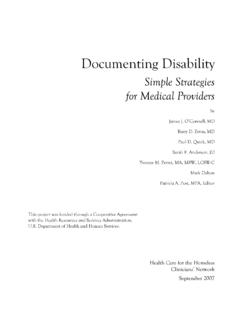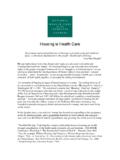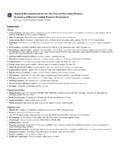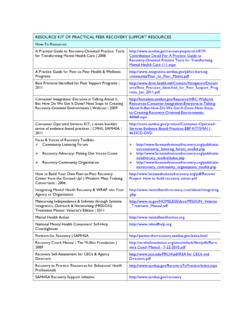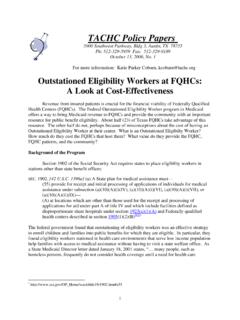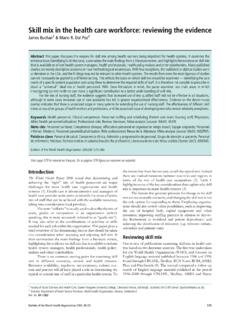Transcription of Community Health Workers in Health care for the Homeless
1 Community Health Workers in Health care for the Homeless A guide for administrators by Katy Valesky, MSSW. National Health care for the Homeless Council June 2011. Community Health W orkers in Health care for the Homeless : a guide for administrators was developed with support from the Bureau of Primary Health care , Health Resources and Services Administration, Department of Health and Human Services. Community Health Workers IN Health care FOR THE Homeless . I diagnosed abdominal pain when the real problem was hunger; I confused social issues with medical problems in other patients, too. I mislabeled the hopelessness of long-term unemployment as depression and the poverty that causes patients to miss pills or appointments as noncompliance. In one older patient, I mistook the inability to read for dementia. My medical training had not prepared me for this ambush of social circumstance. Real-life obstacles had an enormous impact on my patients' lives, but because I had neither the skills nor the resources for treating them, I ignored the social context of disease altogether.
2 Laura Gottlieb, MD, San Francisco Chronicle 8/23/101. INTRODUCTION. The purpose of this guide is to introduce the Community Health worker (CHW) model to HCH. administrators for integration in the HCH model of care . There are multiple existing CHW programs, but this guide is intended to help HCH projects prioritize those parts of the model that are most applicable to practice and funding. This is a first step in our support of integrating cost saving and effective Community Health worker programs into all of the work HCH projects do. BACKGROUND OF Community HEALTHWORKERS. Community Health Workers are employed around the world to address the shortage of doctors and nurses in vulnerable communities and reduce Health disparities. Perez and Martinez2 note that the earliest records of CHWs date back to a shortage of doctors in early 17th century Russia, when lay people, called feldshers, received training to provide basic medical care to military personnel3.
3 In 1940's China, Chairman Mao Tse Tung instituted the program of Barefoot Doctors to address the disproportionate concentration of doctors in cities and other wealthy areas of China. They were given training in basic medicine and sanitation and were assigned to the communities in which they lived. By 1977, there were million barefoot doctors, but the program was abolished in 1981 due to wider distribution of physicians4. Similar models have been utilized in developing nations in South America, Asia, and Africa5. In 1978, the World Health Organization (WHO) recognized the potential for national CHW. programs in promoting primary care6. As in China and other developing nations, there is a large and growing number of very poor who lack access to adequate Health care the in the United States. Among the various efforts to give the most vulnerable Americans access to Health care in the past 40 years has been the creation of various Community Health worker programs a new concept for a developed nation.
4 These programs specifically target Health disparities among a population who lack access to adequate Health care , or fear/distrust the Health care options offered. The two common characteristics of all CHWs are that they share a relationship with their Community ( , shared language, similar age, geography, race/ethnicity, disease, or condition) and the absence of professional medical training7. HOW CAN A CHW CONTRIBUTE TO THE WORK OF AN HCH? CHWs can focus on the resources, motivations, challenges, and strengths of each consumer and the Community as a whole. Community Health Workers are not focused on diagnosis or treatment they are tasked to help the client and the larger Community access medical resources. CHWs improve Health NATIONAL Health care FOR THE Homeless COUNCIL 3 Community Health Workers IN Health care FOR THE Homeless . outcomes through education*, navigation services, enabling services , accompaniment, outreach work, and Community education and advocacy.
5 One of many advantages of employing CHWs is the relatively short time needed for on-the-job training, usually only a few days before they are ready to start helping clients8. COST EFFECTIVENESS AND IMPROVED Health . There are several promising studies showing that Community Health work is an effective tool for reducing Health disparities, improving Health and reducing the cost of Health care10-10. Recent research on the effectiveness of Community Health Workers document a reduction in the use of emergency services and a reduction of hospitalizations while client Health improved, both empirically and self-reported. Fedder10 found that Community Health Workers were especially effective helping people with chronic conditions who are not using a regular source of Health care . He found that after one year of weekly contact with a CHW offering navigation, monitoring, and Health education, study patients enrolled in Medicaid in Baltimore reduced their cost of care by 27% compared to the year prior to working with a CHW.
6 Emergency room visits declined 38% and admissions from ER visits went down 30% during the same period. This was accomplished while patients reported an improvement in their quality of life. Researchers at Denver Health9 utilized a Community Health worker and documented a return on investment of $ for every dollar invested, an average annual net savings of more than $95,000 per Community Health worker . Another study looking at a population of asthma sufferers in Hawaii documented a 75% decrease in overall Health care spending and an 83% drop in emergency room visits after Community Health worker interaction while participants reported improved quality of life10. A CHW Program11 at Brackenridge Hospital, one of the busiest in Austin, Texas and Christus Spohn Hospital in Corpus Christi also report great success using Community Health Workers to divert consumers from costly emergency and uncompensated urgent care in a culturally appropriate way while improving patient-reported quality of life.
7 Christus Spohn Hospital reported an average savings of $25,000 per month as a result of their CHW program. For HCH projects, the cost savings of CHWs are expected to be even greater as more eligible patients become enrolled in Medicaid and Medicare, fewer clients overuse clinic services, and more consumers learn how to manage their Health even within limited means. In addition to expected improvements in physical Health outcomes, there are also psychological benefits for consumers as they learn Health maintenance skills that minimize their need for medical intervention. * education of patients and the general population served by the Health center regarding the availability and proper use of Health services - section 330(b)(1)(A)(v) of the PHS Act . E nabling Services are services that enable individuals to use the services of the Health center (including outreach and transportation services and, if a substantial number of the individuals in the population served by a center are of limited English-speaking ability, the services of appropriate personnel fluent in the language spoken by a predominant number of such individuals) - section 330(b)(1)(A)(iv) of the PHS Act.
8 NATIONAL Health care FOR THE Homeless COUNCIL 4 Community Health Workers IN Health care FOR THE Homeless . NATIONAL EVALUATIONS. Center for Medicaid and Medicare Services Office of Clinical Standards and Quality recently conducted a 28-month study of their Every Diabetic Counts (EDC) program. They found that minorities were underrepresented in the reimbursement requests for tests ordered for diabetic patients such as HBA1C, lipids, and eye exams in over half the states. CHWs were utilized as part of a non-technical team that delivered diabetes self-management education classes to primarily Medicare beneficiaries to increase Health literacy. The results of the EDC program included a 28% increase in HBA1C tests, 25% increase in the tests for lipids, and an 8% increase in eye exams in the six states where the initiative was demonstrated12. Health Resources and Services Administration (HRSA) recently released several studies evaluating Community Health worker programs and workforce development.
9 In 1998, HRSA published a paper entitled Impact of Community Health Workers on access, use of services, and patient knowledge and behavior13. The major finding of this paper is that CHW programs are as diverse as the communities they serve and their challenges are as well. This study led to more attention across the country to the potential benefits of Community Health Workers addressing Health care access, quality, cost, and disparities with a Community -centered approach. In 2002, HRSA furthered the work by publishing A literature review and discussion of research studies and evaluations of the roles and responsibilities of Community Health Workers (CHWs)14 . This study looked at the work of defining roles and the elements of a successful evaluation as documented in 19. reviewed studies. In 2007, HRSA published its Community Health worker National Workforce Study15 , the most comprehensive study of the Community Health worker profession. This study concluded that there is a lack of peer-reviewed literature evaluating the effectiveness of Community Health work, but there is evidence that CHW involvement in the delivery of Health care , Health education, and prevention benefit underserved and vulnerable communities.
10 Two of these three papers are available to read at: ;. DIFFERENT APPROACHES TO Community Health WORK. Several states have implemented various programs and, in 2010, the Department of Labor issued a labor code to Community Health workers16 as an umbrella term, although they are known by various titles such as lay Health advisors , lay Health advocates , lay Health Workers , peer Health promoters and Community Health advisors . In other areas, they are also referred to as village Health Workers , patient advocates , Community Health agents , natural helpers and Community Health aides . In addition, there are specific titles assigned to specific tasks and functions, such as shamans who provide spiritual/herbal healing. Another title, promotores/promotoras de salud is frequently used in border towns and in Migrant Health programs serving native Spanish speakers who lack access to care because of language barriers, immigration status, poverty, fear, or distrust of the American Health care system.




